Alpacas are very susceptible to the toxic effects of facial eczema spores and high risk periods occur during the summer and autumn. The spores, produced by the fungus Pithomyces chartarum, are broken down in the digestive tract releasing the sporidesmin toxin. The toxin is absorbed into the circulation and reaches the liver where it is metabolised, releasing potent free radicals that damage liver cells. Once damaged, the liver irreversibly loses its full metabolic capacity. Consequently, noxious compounds accumulate in the blood stream.
Photodynamic chemicals are some of the noxious compounds. They accumulate in the skin, react with UV light damaging blood vessels and skin cells hence the typical skin lesions seen. Additionally, in severe cases, complete liver failure and death are seen.
What are the signs of Facial Eczema in Alpacas?
The usual symptoms seen in other species affected with Facial Eczema include:
- Irritation
- Restlessness
- Skin swelling, crusting and oozing
- Decreased production/growth rates
- Abortion
- Death
Sudden death is the most common clinical sign seen. Alpacas are reasonably stoic animals and do not often show the subtle early signs that other species do until the liver damage is very severe. Diagnosis is obtained via blood sample and analysis of liver-specific enzyme such as GGT, or via post-mortem.
Prevention and Treatment
Preventing fungal growth and accumulation of spores is by far the most effective way to safeguard your animals against the disease. It is important to know that the key conditions favouring fungal growth are:
- Accumulated dead litter at the base of the sward, in summer/autumn
- Warm, moist conditions especially in north-facing slopes
- Grass base temperature greater than 10oC for more then 2-3 days
and once produced, the spores remain a risk i.e. you have a contaminated pasture.
Measures that are useful in preventing fungal growth are:
- Efficient pasture grazing, minimizing litter accumulation at the base of the sward. Use other grazing species to graze excess pasture.
- If you are considering mowing pasture, think of a way to remove the dead matter
- If you mow, but can not remove dead grass, use a set of chain harrows (a set of interlocked chains/metal spikes) to stir and expose the dead matter, hence minimizing fungal growth. Chain harrows come in all sizes and there will be one suitable for your property.
- Use fungicide sprays to prevent fungal growth. However, once the spores are present, spraying offers no protection.
- Identify higher risk paddocks, and monitor spore levels by carrying out spore counts and managing accordingly.
To assist in the prevention of free-radical damage to the liver, the most practical and effective option is:
- supplementation of 2g of elemental zing per 100 kilo liveweight per day. Start early, about 3 weeks before the danger period and carry out for approximately 100 days (this is a recommendation normally applicable to other ruminants but the time period in alpacas is not really known). The best response is achieved by mixing it with molasses and offering to the animals. Other options exist but are generally not as effective.
- homeopathic remedies can also be added to the water but should be used in conjunction with and not as a substitution for zinc.
Treatment of Affected Animals
The damage to the liver is generally permanent but some degree of regeneration can occur. Animals showing symptoms need:
- shelter from sunlight, and darkness is best
- reduced protein feeds
- use protective, nourishing skin creams to soothe sensitive areas
- minimize stress by making water and feed easily accessible to the animal
- liver-specific supportive homeopathic treatments
Other treatments may be possible but will depend on age, condition and pregnancy status of animals.
In summary, manage your pastures adequately, start zinc supplementation early, be aware of the district spore count levels and contact us as soon as possible if you suspect any animal is affected.






